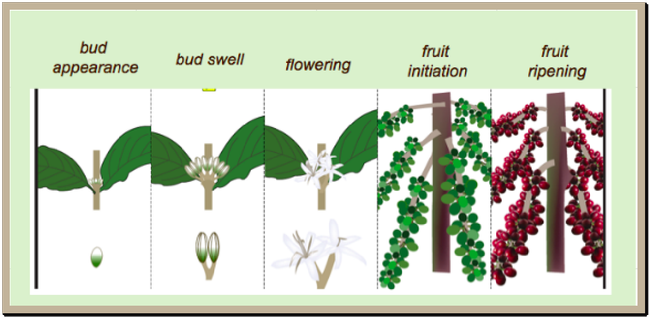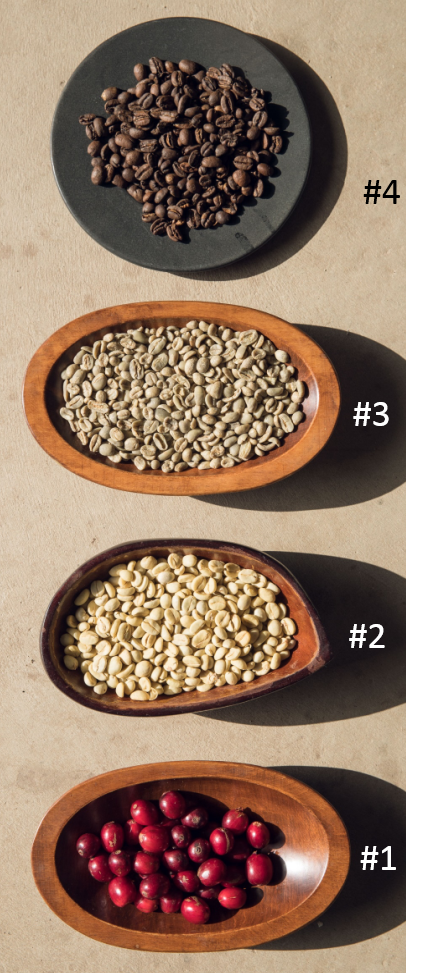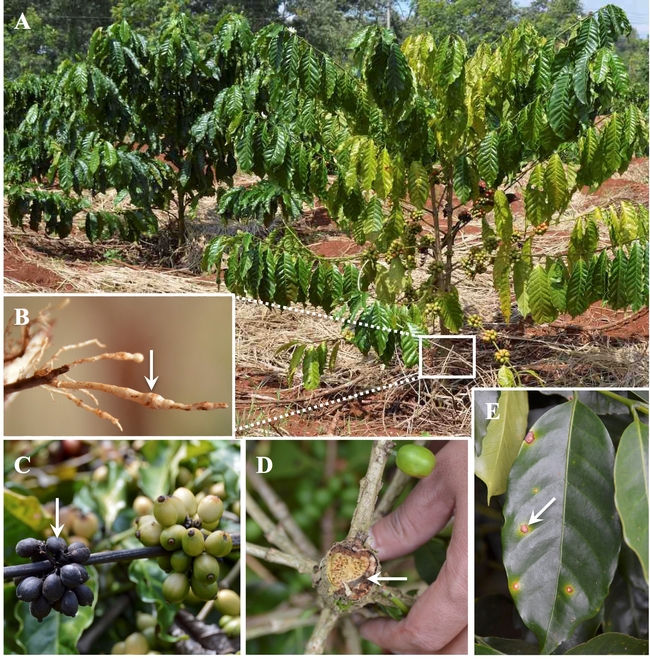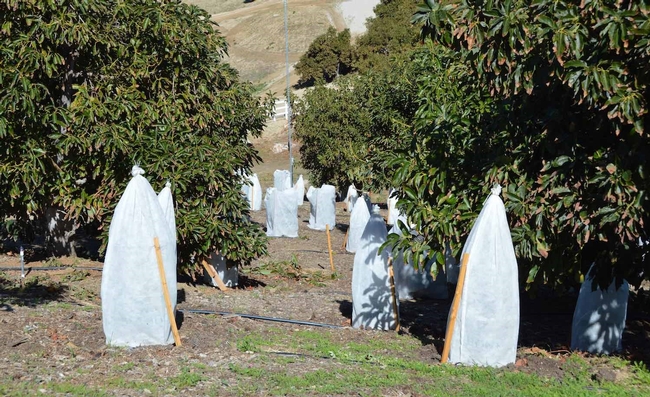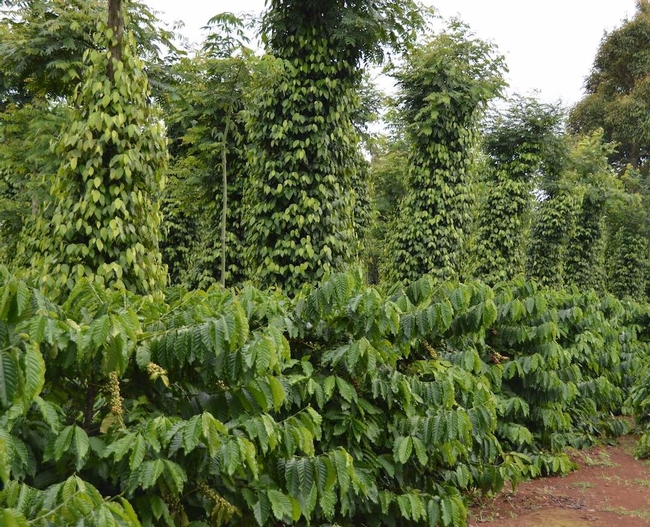
Posts Tagged: coffee
A Taste of Coffee
Coffee is one of the top 3 most traded commodities in the world. About 12 billion pounds of coffee are consumed each year worldwide. In the US, coffee consumption has been steadily increasing and today Americans average about 4 cups of coffee per day. The US coffee market is worth over $75 billion with 34,000 shops generating $21 billion in retail revenue. The average American consumer is becoming increasingly educated about coffee and many have become connoisseur. Producing dry coffee beans (Fig.1 #4 ) is in many ways similar to wine making because coffee can reflect the character of a variety. After harvest, the berries (a.k.a. cherry; Fig.1 #1) are fermented. During this process yeasts break down the mucilage (i.e., the flesh around the bean). The parchment (Fig.1 #2) that remains around the green beans (Fig.1 #3 ) is subsequently removed by dry milling before roasting. Also just like for wine, coffee aroma profile and organoleptic properties are graded and referred to as a cupping score, which has been developed by the Specialty Coffee Association, a nonprofit, membership-based organization that represents thousands of coffee professionals (https://sca.coffee).
|
Figure 1 - Coffee flower and fruit stages ( # 1 - #4) |
|
Figure 2 - Major diseases encountered in Vietnam coffee production. A-B: Root-Knot nematode. C: Colletotrichum. D: Insect borer. E: Rust |
Coffee (Rubiaceae family) is concentrated in the tropics and subtropics. The genus Coffea has over 60 species of which C. canephora (a.k.a. Robusta) and C. Arabica are the most common ones. Arabica coffee is praised for its excellent cupping quality and consumers demand is high. The US coffee market is dominantly Arabica and imports mainly from Brazil but other importing markets include Asia. I had the privilege to be invited by Dr. Dzung Anh Nguyen at Tay Nguyen University in Dak Lak province, Central highland region of Vietnam, to educate myself about the art of growing coffee and its challenges. Vietnam produces 3 billion lbs of coffee beans annually on 1.5 million acres (95% Robusta and 5% Arabica) and exports about 0.4 billion lbs of coffee to the US, although its main market streams are Europe, Japan and Korea. This industry is valued at $4 billions, with over $3 billions to export. In Vietnam, Arabica yields about 1-2 tons per Ha at $4,000 per ton, whereas Robusta yield twice as much for half the price. France introduced coffee production in Vietnam around 1915. The culture of coffee is now anchored deep in this region and a corner stone of the local economy. The elevation of the central highland in Vietnam ranges from 1500 to 6,000 feet. Above 3000 feet, Arabica is grown and Robusta below that line. The acidic soil, rain pattern and high elevation provide a unique environment for Arabica coffee plants. In addition, high elevation limits the incidence and severity of coffee rust. This fungal disease is a major limiting factor to coffee production worldwide. Robusta is known to be more tolerant to the disease and can be grown at lower elevation where disease pressure is higher. Besides rust, coffee berry borer, nematodes and soil borne fungal pathogens can cause devastating losses in coffee growing regions. Invasive pests and diseases, global warning, water availability and quality are key variables that need to be factored into market projection growth and availability of the supply chain. According to the Australia's Climate Institute's, hotter weather and changes in rainfall patterns are projected to cut the area suitable for coffee in half by 2050.
In the US, Hawaii is the leading coffee producer with 38 million lbs of cherry on 7,000 bearing acres in 2017 (USDA Statistics). As a reference point, a pound of Kona coffee cost about $35-50 at a retail store. In California coffee is not a commodity but a niche market that produces rare and specialty coffee. This is the fastest growing segment of the US coffee market and it has been valued at over $40 billion. In the past decade, California has become a fertile region for coffee. There was currently about 30-farms and 30,000 trees but with projections of 60,000 in this upcoming year. Research led at UC Davis has provided valuable science –based information (including the Arabica genome sequencing) to coffee production under our climate. In collaboration with the UC Cooperative Extension and specifically Mark Gaskell, practical guidelines have been developed to optimize coffee production in our region that includes selection of adapted varieties, plant nutrition and irrigation needs http://ceventura.ucanr.edu/Com_Ag/Subtropical/Minor_Subtropicals/Coffee_/
Evidence suggests that the mesoclimate of southern California (i.e., where avocado is grown) provides enough heat and sunlight units to grow Arabica. California also offers the unique advantage of having no serious pests or diseases. Another major advantage is the use of automated and controlled irrigation because it has favored optimal fruit set and maturation. The only limiting factors can be alkaline soils and cold temperatures both of which can be managed by soil acidification (with sulfur and pit moss applications) and tree protection at the establishment of the orchard. Orchards of inter-planted coffees plants and avocado are common to provide shading. Likewise in the low lands of Vietnam robusta trees were inter-planted with pepper trees. This model also offers an economic advantage to maximize land surface and increasing profit. The California business model developed under the leadership of FRINJ coffee (www.frinjcoffee.com) and Good Land Organics (www.goodlandorganics.com) has boosted the local coffee industry. They have the ambitious goal to make California the world capital of specialty coffee. Adopting a science-guided approach has provided a solid foundation to make coffee farming lucrative. The start up costs for coffee production are the same as for avocado, but can be 3 times more profitable. In the current marketplace, specialty coffee price can range between $60-300 per pound (that's a $8-16 per cup). The quality of FRINJ coffee has received international recognition for its quality (it ranked 27th for best coffee of 2015) and this storyline was highlighted in the New-York Times. (https://www.nytimes.com/2017/05/26/business/your-coffee-is-from-where-california.html).
Figure 3: Coffee farm in the US (top) and Vietnam (bottom). Coffee plants are inter-planted with avocado and pepper trees to provide shade for coffee and optimize land surface.

coffee fields vietnam
Another Way to Figure Out What to Grow and Market
USDA Specialty Crops, the Agricultural Marketing News Service and What's Worth Planting
The AMS Specialty Crops Program helps buyers and sellers of all sizes in the U.S. produce industry to market their perishable products in the most efficient manner. They partner with State agencies and other industry organizations for the benefit of nationwide growers, shippers, brokers, receivers, processors, retailers and restaurants, direct to consumer sales, and the foodservice industry.
The program offers a wide array of services that span from helping market the quality of products to ensuring that there is fair trade in the produce industry. The program also helps specialty crops growers and handlers to combine their resources to help their respective industries overcome marketing barriers.
This is also a great website for trolling for potential alternative crops – what is selling, where, for how much and whether it might be a good idea to plant that crop. Check it out:
Main page of AMS:
https://www.ams.usda.gov/market-news/fruits-vegetables
Choose from different fruits:
https://www.marketnews.usda.gov/mnp/fv-nav-byCom?navClass=FRUITS&navType=byComm
For avocados you can see what the various prices are in different markets and times:
If you are interested in coffee prices, it's still considered a "commodity" and a California grown coffee will not be listed:
https://www.fas.usda.gov/data/search?f[0]=field_commodities:609
The USDA Specialty Crops Program also has a food safety certification program that might be of help to growers. In April 2016, the Specialty Crops Program's Specialty Crops Inspection Division (SCI) launched GroupGAP, a new food safety certification program that is part of our USDA Good Agricultural Practices (GAP) suite of services. Our voluntary USDA GAP programs help verify that produce growers and handlers have taken measures to reduce the risk of contamination. Commercial buyers look for USDA GAP-certified suppliers to source safe specialty products. While larger operations can devote the resources needed to become GAP certified, some smaller entities cannot. Until now. GroupGAP allows farmers, food hubs, and marketing organizations of all sizes to band together and pool resources to achieve USDA GAP certification.

tropical-fruit
A Story about Cooperative Extension
This is a story about phone calls that come in to my message machine. Yesterday I got 3 calls from PCAs (Pest Control Advisors) and two from growers. The two from growers were from a Papaya grower and the other from a dragon fruit grower that I am working with to develop an industry here in Santa Barbara/Ventura. One is in Carp the other in Montecito. The PCA calls were from two that work on avocado and the other from a citrus grower. I either get a call from an avocado grower direct because they can't afford a PCA or from the manager or the PCA of larger farms. From citrus it is usually the manager or the PCA. These are more developed industries and the grower usually lets the workers take care of problems because they are so familiar with the operations. When it ‘s a new crop, the owner steps in. They want to know all that can go wrong with this new crop.
Blueberries are expanding now along the coast and when we first started working on them 15 years ago, our collaborators were in touch with us constantly. Now it's the managers who call. Its now a developed industry. The same for coffee. When we started working on it we worked closely with out cooperators, now there is a coffee cooperative that takes care of itself. We work with new things. One of the calls from an avocado PCA was about a farm that is being infested with bagrada bug. Everything in the area has dried up from the drought. The bagarada bug normally goes after plants in the brassica family (cabbage, mustard, etc.), many of which are native and growing along streams and on hillsides. The streams and hills have dried up and the bug is now going to the new avocado leaf tissue and the PCA wanted the bug identified and to provide a solution to the problem.
Sometimes the weather works for us and sometimes against us. We've got a parasitic wasp for controlling olive fruit fly. We went out all over southern Santa Barabara county to groves of olive trees to determine where to release the wasp and could find healthy olives, but no olive fruit. No where to make to make releases this year. The weather plays tricks on us. But we keep looking for solutions. Maybe next year we will be able to study if and how the wasp controls olive fruit fly. It does in France.

ANR
Coffee in California?
Who a thunk it, but coffee can grow in coastal California, because our latitude approximates the climate found in high altitude coffee growing areas found in Central America. And now there is a "small" industry growing here.
Of all coffee species, Coffea arabica is considered to make the superior beverage. It accounts for more than three-quarters of the world production in spite of being prone to a devastating rust disease. C. arabica is indigenous primarily to the area around Kaffa in Ethiopia. For many years this area was "closed", and the genetic breeding pool was limited to one seedling taken to Amsterdam in 1706 from a planting in the East Indies. The resultant inbreeding still may be a significant factor in what cultivars are presently available.
The first "coffee" drink was made from fermented fruit pulp. Not until the 15th century were dried "coffee" beans roasted, ground and a beverage extracted. In 1650 coffee from Arabia reached England, and by 1675 there were more than 3,000 forerunners of StarbucksTM.
C. arabica thrives and produces the most prized beans in the moderate (maximum of about 70o F) climates encountered at higher, frost-free elevations. Excellent coffee is produced near the equator up to 6000 feet. Growing conditions at this elevation correspond approximately to the coastal conditions at 34 degrees latitude (Santa Barbara and Ventura Counties). A good tasting coffee has been made from beans grown in Santa Barbara backyards.
Challenges facing production in California include adapting cultural techniques to California conditions, marketing California specialty coffees, and minimizing labor costs attendant with picking and grading without significantly degrading product quality.

coffee

